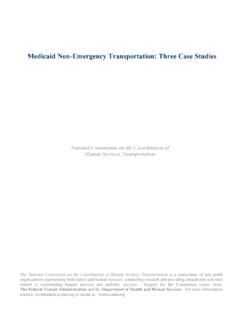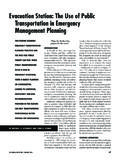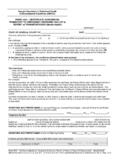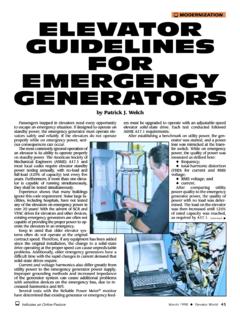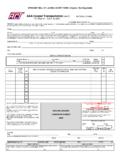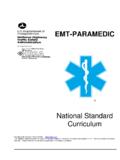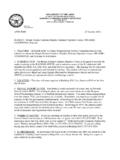Transcription of Transportation of Dangerous Goods Road Version
1 Transportation ofDangerous GoodsRoad VersionReference Guide for TraineesPage 2 TDG Reference Guide - RoadINDEXT opic PageIntroduction ..3 Training Requirements ..5 Classes6 Shipping Documents10 Safety Marks13 Means of Containment17 Accidental Releases18 Reporting Requirements18 Guideline for Consignor (Shipper)21 Guideline for Carrier (Driver)22 This TDG Reference Guide follows the Guidelines for Training criteria thathas been established by Transport information included in this material represents the opinion of theSundown Development Group and its Advisors and should not beconstrued as being either official or unofficial policy of any Reference Guide is not all-encompassing. It does not engage inrendering legal or other professional 3 TDG Reference Guide - RoadIntroductionComing into Force, Repeal, Interpretation, General Provisions and Special CasesPart 1 ClassificationPart 2 DocumentationPart 3 Dangerous Goods Safety MarksPart 4 Means of ContainmentPart 5 TrainingPart 6 Emergency Response Assistance PlanPart 7 Accidental Release and Imminent Accidental Release Report RequirementsPart 8 RoadPart 9 RailPart 10 MarinePart 11 AirPart 12 Protective DirectionPart 13 Permit for Equivalent Level of SafetyPart 14 Court OrderPart 15 InspectorsPart 16 SCHEDULESS chedule 1 Classes 1 to 9 Schedule 2 Special ProvisionsSchedule 3 Alphabetical IndexIMPORTANT:An up to date copy, or access to the TDG Regulations, must be available in order to take this course and function inthe workplace.
2 The internet site for TDG can be found at .. 4 TDG Reference Guide - RoadSchedule 1 Classes 1 to 9 Col. 1 Col. 2 Col. 3 Col. 10 Col. 9 Col. 8 Col. 7 Col. 6 Col. 5 Col. 4 UNNumberShiping Name and DescriptionClassPackingGroup /CategorySpecialProvisionsExplosiveLimit &LimitedQuantityIndexERAPI ndexPassengerCarryingShip IndexPassengerCarryingRoadVehicle orpassengerCarryingRailwayVehicleIndexMa rinePollutantUN 1203 GASOLINEMOTOR SPIRIT; orPETROL3ll17, 82, 88100P305 IntroductionSample CopySee SP82 Page 5 TDG Reference Guide - RoadWhat is expected, as per the TDG Act ..Section person is adequately trained, for road transport, if the person has a sound knowledge of all the topics listed inparagraphs (a) to (k) that relate directly to the person s duties and to the Dangerous Goods the person is expected tohandle, offer for transport, or transport:(a) the classification criteria and test methods in Part 2, Classification;(b) shipping names;(c) the use of Schedules 1,2 and 3;(d) the shipping document.
3 Requirements in Part 3, Documentation;(e) the Dangerous Goods safety marks requirements in Part 4, Dangerous Goods Safety Marks;(f) the certification safety marks requirements, safety requirements and safety standards in Part 5, Means ofContainment;(g) the emergency response assistance plan requirements in Part 7, Emergency Response Assistance Plan;(h) the report requirements in Part 8, Accidental and Imminent Accidental Release Report Requirements;(i) safe handling and Transportation practices for Dangerous Goods , including the characteristics of the dangerousgoods;(j) the proper use of any equipment used to handle or transport the Dangerous Goods ; and(k) the reasonable emergency measures the person must take to reduce or eliminate any danger to public safetythat results or may reasonably be expected to result from an accidental release of the Dangerous training is required for people involved in shipments of Dangerous Goods by air or by employer may issue a training certificate when he/she has reasonable grounds to believe that an employeepossesses adequate training (see last page).
4 The employer must keep a record of the training that the employee has received and a copy of his/her trainingcertificate (Section ). The training certificate must be immediately presented to an inspector who requests for it(Section ).Training RequirementsPage 6 TDG Reference Guide - RoadClass 1 ClassesClass DivisionCharacteristics of Dangerous Goods1 Explosives(Section - ) substance or article with a mass explosion hazardA substance or article with a projection hazard but not a massexplosion hazardA substance or article which has a fire hazard and either a minorblast hazard or a minor projection hazard, but does not have a massexplosion hazardA substance or article which presents no significant hazard -explosion effects are localized to immediate surroundingsA very insensitive substance with a mass explosion hazardExtremely insensitive substances with no mass explosion hazard1 . 2 DClass 2 Class DivisionCharacteristics of Dangerous Goods2 Gases(sections ) flammable gas which is easily ignited and burnsA non-flammable, non-toxic, non-corrosive gasA gas which is poisonous or corrosive to humansPage 7 TDG Reference Guide - RoadClass 3 ClassesClass DivisionCharacteristics of Dangerous Goods3 Flammable Liquids(sections )No DivisionsA flammable liquid with a closed-cup flash point less than 60 shipments intended or expected to be at a temperaturegreater than their flashpoint are also considered to be 4 Class DivisionCharacteristics of Dangerous Goods4 Flammable Solids(sections )
5 Flammable solid which is readily combustible and cause firethrough friction or from heat retained from manufacturingA spontaneously combustible substance that ignites when exposedto A water-reactive substance which emits flammable gas when itcomes into contact with waterPage 8 TDG Reference Guide - RoadClass 5 Class DivisionCharacteristics of Dangerous Goods5 OxidizingSubstances, OrganicPeroxides(sections ) oxidizing substance which may yield oxygen andcontribute to the combustion of other An organic peroxide which releases oxygen readilyand may liable to explosive decomposition, orsensitive to heat, shock or frictionClass 6 Class DivisionCharacteristics of Dangerous Goods6 Toxic and InfectiousSubstances(sections ) toxic substance that is liable to cause harm tohuman healthAn infectious substanceClassesClass 7 Class DivisionCharacteristics of Dangerous Goods7 Radioactive Materials(sections )No DivisionsRadioactive materials as defined by the NuclearSafety and Control ActPage 9 TDG Reference Guide - RoadClass 8 Class DivisionCharacteristics of Dangerous Goods8 CorrosiveSubstances(sections )No DivisionsSolids or liquids such as acids or alkalis materials thatcause destruction of the skin or corrode metalsClass 9 Class DivisionCharacteristics of Dangerous Goods9 MiscellaneousDangerous Goods (sections )No DivisionsA regulated substance that cannot be assigned to any other class.
6 Itincludes genetically modified microorganisms, marine pollutants,substances transported at elevated temperature, substances thatrelease toxic substances through leaching, and environmentallyhazardous substances intended for addition to the class and division, some Dangerous Goods are also assigned packing groups. These groups reflectthe level of hazard that Dangerous Goods GroupLevel of HazardIVery hazardous substancesIIHazardous substancesIIIM oderately hazardous substancesThe assignment of packing groups is done according to chemical and physical testing requirements outlined for eachclass of Dangerous Goods in Part 2 of the TDG Group:Page 10 TDG Reference Guide - RoadDangerous Goods Shipping DocumentConsignor Name and Address: Primary & UN Packing Quantity and Number of Control & Subsidiary Number Group Unit of Small Emergency Class(es)
7 Measure Means of Temperatures Containment that Require a Label Total Gross MassERAP Reference Number &Telephone: 24-Hour Phone Number:Date:Sample CopyShipping DocumentsShipping NameDGPage 11 TDG Reference Guide - RoadShipping DocumentsThe following is the minimum required information which must appear on a shipping document:Shipping Document InformationDateName and address of consignorDescription of Goods in the following order:a.
8 Shipping nameb. The technical name of the most Dangerous substancerelated to the primary classificationc. The words Not Odorized d. Primary classificatione. Compatibility classificationsg. UN numberh. Packing group (none for compressed gases)The quantity in the International System of UnitsNet explosives quantityThe number of containersThe words 24-Hour Number followed by atelephone number where the consignor can beeasily reachedEmergency Response Assistance Plan (ERAP)number and telephone number to activate itThe control and emergency temperaturesWhen RequiredAlwaysAlwaysAlwaysIf Provision 16 ofSchedule 2 appliesFor liquefied petroleumgas that has not beenodorizedAlwaysFor Class 1If AnyAlwaysIf AnyAlwaysFor Class 1 For Dangerous Goods insmall containersrequiring safety labelsAlwaysIf RequiredFor products in and in (1)(b) (1)(a) (1)(c) (1)(c)(i) (1)(c)(i)(A) (1)(c)(i)(B) (1)(c)(ii) (1)(c)(iii) (1)(c)(iv) (1)(c)(v) (1)(c)(vi) (1)(d) (1)(d) (1)(e) (1)(f) (1) (3)The shipping document is handed over to the initial carrier and must accompany the consignment throughout itsjourney.
9 The consignor and each carrier that transported shall retain a copy of the shipping document for a period oftwo years (Sections and ).Page 12 TDG Reference Guide - Road Residue Last Contained If the quantity of Dangerous Goods is less than 10% of the container s capacity then the words Residue LastContained followed by the shipping name of the Dangerous Goods that was last contained in the means ofcontainment may be used to describe the does not apply to Class 2 gases in small containers and Class 7 radioactive substances [Section (4)].Changes during transport:If the quantity of Dangerous Goods or the number of small means of containment changes during transport, the carriermust show on the shipping document or on a document attached to the shipping document the change in the quantityof Dangerous Goods or the number of small containers [Section (5)].24-Hour Number Permission Required:A consignor can also use the telephone number of an agency that is competent to give the technical information onthe shipment.
10 For example, it is possible to use CANUTEC as a source of technical information provided that theconsignor has received permission in writing from CANUTEC [Section (2)].Shipping DocumentsPage 13 TDG Reference Guide - RoadSafety MarksThe Consignor:The consignor is responsible for choosing and displaying safety marks on all means of containment carrying dangerousgoods. They are described in Part 4 of the TDG you are shipping or importing, it s your responsibility to provide the proper placard(s).If the carrier is transporting other Dangerous Goods , you must figure out which placards should be Handler:It is your responsibility to ensure that the proper placards are in place before any Dangerous Goods have been loadedinto or onto a large means of must also ensure that the required safety marks are in place on a means of containment until it has been emptied,cleaned, purged or this has been done, you must then remove all safety marks from both the large and small means of Carrier:The carrier is responsible for making sure that the safety marks remain displayed during transport, and that alsoincludes the safety marks on all the small means of containment within you vehicle or carrier is also responsible for removing or changing the safety marks if the requirements for Dangerous goodssafety marks change during transport [Section (1)].

